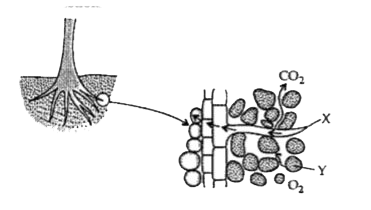Given below is a diagram depicting a physiological process in plants. Study the same and answer the following questions :

Define the part X.
Woody and older roots have tiny openings called lenticels. With the help of lenticels, these roots exchange gases between the inner living cells and the atmosphere.
Topper's Solved these Questions
- RESPIRATION IN PLANTS BOOK - ICSECHAPTER - RESPIRATION IN PLANTS EXERCISE - 3 Mark Questions
9 Videos
- POLLINATION AND FERTILIZATION BOOK - ICSECHAPTER - POLLINATION AND FERTILIZATION EXERCISE - TOPIC 2 (5 Marks Questions )
18 Videos
- RESPIRATORY SYSTEMBOOK - ICSECHAPTER - RESPIRATORY SYSTEMEXERCISE - TOPIC-2 (5 Marks Questions)
14 Videos
Similar Questions
Given below is a diagram depicting a physiological process in plants. Study the same and answer the following questions:

Label the part .X. and .Y..
View SolutionGiven below is a diagram depicting a physiological process in mammals.
Study the same and answer the following questions :
Label the part .X. and .Y..
View SolutionGiven below is a diagram depicting a physiological process in animals.

Study the same and answer the following questions:
Define tissue respiration.
View SolutionGiven below is a diagram depicting a physiological process in plants.
Study the same and answer the following questions :

Write two adaptations of flowers showing this process.
View SolutionGiven below is a diagram depicting a physiological process in man.
Study the same and answer the following questions :

Label the gases .X. and .Y..
View SolutionGiven below is a diagram depicting a physiological process in plants.
Study the same and answer the following questions :

Write two examples of plants showing this process.
View SolutionGiven below is a diagram depicting a physiological process in plants. Study the same and answer the following questions:

Write two examples of plants showing this process.
View SolutionGiven below is a diagram depicting a physiological process in plants.
Study the same and answer the following questions :

How does stigma trap the pollen?
View SolutionGiven below is a diagram depicting a physiological process in mammals. Study the same and answer the following questions :
(i)Name the process occurring in the diagram.
(ii)Explain the process mentioned in part (i).
View SolutionGiven below is a diagram depicting a physiological process in animals.

Study the same and answer the following questions:
Explain both the process shown in figure ‘X. and .Y..
View Solution
